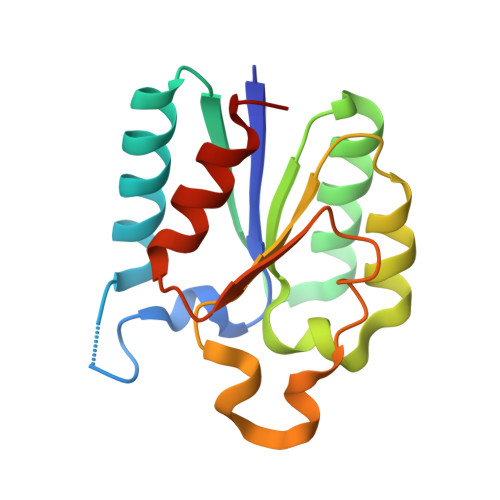Structural investigation of inhibitor designs targeting 3-dehydroquinate dehydratase from the shikimate pathway of Mycobacterium tuberculosis.
Dias, M.V., Snee, W.C., Bromfield, K.M., Payne, R.J., Palaninathan, S.K., Ciulli, A., Howard, N.I., Abell, C., Sacchettini, J.C., Blundell, T.L.(2011) Biochem J 436: 729-739
- PubMed: 21410435
- DOI: https://doi.org/10.1042/BJ20110002
- Primary Citation of Related Structures:
3N59, 3N76, 3N7A, 3N86, 3N87, 3N8K, 3N8N - PubMed Abstract:
The shikimate pathway is essential in Mycobacterium tuberculosis and its absence from humans makes the enzymes of this pathway potential drug targets. In the present paper, we provide structural insights into ligand and inhibitor binding to 3-dehydroquinate dehydratase (dehydroquinase) from M. tuberculosis (MtDHQase), the third enzyme of the shikimate pathway. The enzyme has been crystallized in complex with its reaction product, 3-dehydroshikimate, and with six different competitive inhibitors. The inhibitor 2,3-anhydroquinate mimics the flattened enol/enolate reaction intermediate and serves as an anchor molecule for four of the inhibitors investigated. MtDHQase also forms a complex with citrazinic acid, a planar analogue of the reaction product. The structure of MtDHQase in complex with a 2,3-anhydroquinate moiety attached to a biaryl group shows that this group extends to an active-site subpocket inducing significant structural rearrangement. The flexible extensions of inhibitors designed to form π-stacking interactions with the catalytic Tyr24 have been investigated. The high-resolution crystal structures of the MtDHQase complexes provide structural evidence for the role of the loop residues 19-24 in MtDHQase ligand binding and catalytic mechanism and provide a rationale for the design and efficacy of inhibitors.
Organizational Affiliation:
Department of Biochemistry, University of Cambridge, 80 Tennis Court Road, Cambridge CB2 1GA, UK.















